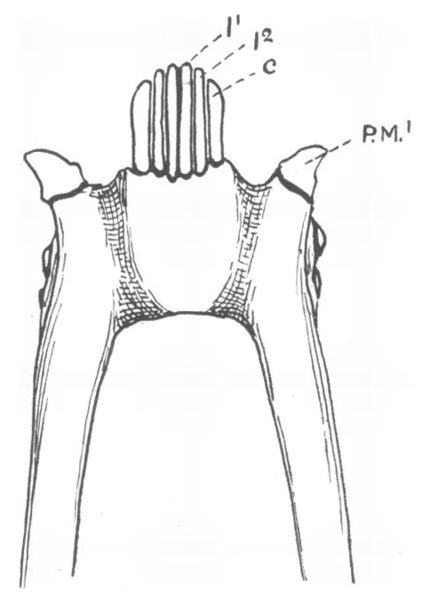
Size of this preview: 422 × 600 pixels. Other resolutions: 169 × 240 pixels | 475 × 675 pixels.
Original file (475 × 675 pixels, file size: 55 KB, MIME type: image/jpeg)
Summary
[edit]| Description |
An illustration of a toothcomb of a ring-tailed lemur (Lemur catta) shown from the underside of the lower jaw. |
|---|---|
| Source |
Wood Jones, F. (1918). "The sublingua and the plica fimbriata". Journal of Anatomy. 52 (Pt 4): 345–353. PMC 1262842. PMID 17103846. |
| Date |
1918 |
| Author |
Frederic Wood Jones (23 January 1879 – 29 September 1954) |
| Permission (Reusing this file) |
Public domain in the United States because of its publication date. However, the image was probably first published in the United Kingdom, where it will retain copyright until 1 January 2025.
|
Licensing
[edit]File history
Click on a date/time to view the file as it appeared at that time.
| Date/Time | Thumbnail | Dimensions | User | Comment | |
|---|---|---|---|---|---|
| current | 05:56, 6 March 2012 |  | 475 × 675 (55 KB) | Maky (talk | contribs) | {{Information |Description = An illustration of a toothcomb of a ring-tailed lemur (''Lemur catta'') shown from the underside of the lower jaw. |Source = {{cite pmid | 17103846}} |Date = 1918 |Author = [[Frederi... |
You cannot overwrite this file.
File usage
The following pages on the English Wikipedia use this file (pages on other projects are not listed):
Well, that’s interesting to know that Psilotum nudum are known as whisk ferns. Psilotum nudum is the commoner species of the two. While the P. flaccidum is a rare species and is found in the tropical islands. Both the species are usually epiphytic in habit and grow upon tree ferns. These species may also be terrestrial and grow in humus or in the crevices of the rocks.
View the detailed Guide of Psilotum nudum: Detailed Study Of Psilotum Nudum (Whisk Fern), Classification, Anatomy, Reproduction